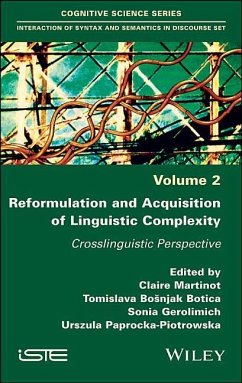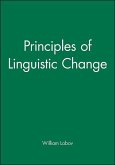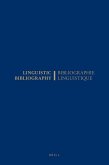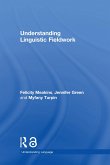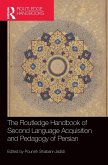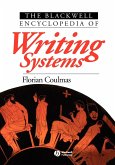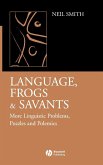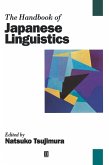Reformulation and Acquisition of Linguistic Complexity
Crosslinguistic Perspective
Herausgeber: Martinot, Claire; Paprocka-Piotrowska, Urszula; Gerolimich, Sonia; Botica, Tomislava Bosnjak
Reformulation and Acquisition of Linguistic Complexity
Crosslinguistic Perspective
Herausgeber: Martinot, Claire; Paprocka-Piotrowska, Urszula; Gerolimich, Sonia; Botica, Tomislava Bosnjak
- Gebundenes Buch
- Merkliste
- Auf die Merkliste
- Bewerten Bewerten
- Teilen
- Produkt teilen
- Produkterinnerung
- Produkterinnerung
Reformulation and Acquisition of Linguistic Complexity proposes a new answer to the question of the appropriation or acquisition of a mother tongue - a complex object, one that is both stable and perpetually evolving. This answer is based on the reformulating principle that children spontaneously apply; a principle that is illustrated here with children retelling the same story. These children are all 6, 8 or 10 years old and speak French, Italian, Croatian or Polish as a first language. This book demonstrates that the acquisition of any mother tongue is explained by the application of various…mehr
Andere Kunden interessierten sich auch für
![Principles of Linguistic Change, 3 Volume Set Principles of Linguistic Change, 3 Volume Set]() William LabovPrinciples of Linguistic Change, 3 Volume Set158,99 €
William LabovPrinciples of Linguistic Change, 3 Volume Set158,99 €![Linguistic Bibliography for the Year 1982 / Bibliographie Linguistique de l'Année 1982 Linguistic Bibliography for the Year 1982 / Bibliographie Linguistique de l'Année 1982]() BorkentLinguistic Bibliography for the Year 1982 / Bibliographie Linguistique de l'Année 1982849,99 €
BorkentLinguistic Bibliography for the Year 1982 / Bibliographie Linguistique de l'Année 1982849,99 €![Understanding Linguistic Fieldwork Understanding Linguistic Fieldwork]() Felicity MeakinsUnderstanding Linguistic Fieldwork206,99 €
Felicity MeakinsUnderstanding Linguistic Fieldwork206,99 €![The Routledge Handbook of Second Language Acquisition and Pedagogy of Persian The Routledge Handbook of Second Language Acquisition and Pedagogy of Persian]() The Routledge Handbook of Second Language Acquisition and Pedagogy of Persian331,99 €
The Routledge Handbook of Second Language Acquisition and Pedagogy of Persian331,99 €![The Blackwell Encyclopedia of Writing Systems The Blackwell Encyclopedia of Writing Systems]() Florian CoulmasThe Blackwell Encyclopedia of Writing Systems89,99 €
Florian CoulmasThe Blackwell Encyclopedia of Writing Systems89,99 €![Language, Frogs and Savants Language, Frogs and Savants]() Neil SmithLanguage, Frogs and Savants129,99 €
Neil SmithLanguage, Frogs and Savants129,99 €![The Handbook of Japanese Linguistics The Handbook of Japanese Linguistics]() The Handbook of Japanese Linguistics334,99 €
The Handbook of Japanese Linguistics334,99 €-
-
-
Reformulation and Acquisition of Linguistic Complexity proposes a new answer to the question of the appropriation or acquisition of a mother tongue - a complex object, one that is both stable and perpetually evolving. This answer is based on the reformulating principle that children spontaneously apply; a principle that is illustrated here with children retelling the same story. These children are all 6, 8 or 10 years old and speak French, Italian, Croatian or Polish as a first language. This book demonstrates that the acquisition of any mother tongue is explained by the application of various reformulation procedures between source predications and reformulated predications. These procedures are comparable from one language to another, and different from one age group to another. This book also studies certain complex phenomena at the lexical and syntactical levels, and analyzes how children, depending on their age, treat these phenomena. Finally, we show that the acquisition of a mother tongue is a fundamentally linguistic activity.
Hinweis: Dieser Artikel kann nur an eine deutsche Lieferadresse ausgeliefert werden.
Hinweis: Dieser Artikel kann nur an eine deutsche Lieferadresse ausgeliefert werden.
Produktdetails
- Produktdetails
- Verlag: Wiley
- Seitenzahl: 400
- Erscheinungstermin: 21. Mai 2019
- Englisch
- Abmessung: 236mm x 163mm x 30mm
- Gewicht: 794g
- ISBN-13: 9781786303677
- ISBN-10: 1786303671
- Artikelnr.: 55021966
- Herstellerkennzeichnung
- Libri GmbH
- Europaallee 1
- 36244 Bad Hersfeld
- gpsr@libri.de
- Verlag: Wiley
- Seitenzahl: 400
- Erscheinungstermin: 21. Mai 2019
- Englisch
- Abmessung: 236mm x 163mm x 30mm
- Gewicht: 794g
- ISBN-13: 9781786303677
- ISBN-10: 1786303671
- Artikelnr.: 55021966
- Herstellerkennzeichnung
- Libri GmbH
- Europaallee 1
- 36244 Bad Hersfeld
- gpsr@libri.de
Claire Martinot is Professor of Linguistics at Paris-Sorbonne University, France. Tomislava Bonjak Botica is a Full Member of the Institute of the Croatian Language and Linguistics of Zagreb, Croatia. Sonia Gerolimich is Lecturer of the French Language at the University of Udine, Italy. Urszula Paprocka-Piotrowska is Professor of Acquisition and Didactics of Languages at the John Paul II Catholic University of Lublin, Poland.
Preface ix Claire MARTINOT Chapter 1. Why Must We Search for a New Explanation for the Acquisition of a Mother Tongue? 1 Claire MARTINOT 1.1. A child's transformation of the source language: a necessary passage 1 1.2. From transformation to reformulation 6 1.3. Reformulation procedures 7 1.3.1. List of reformulation procedures 9 1.3.2. Characterization of reformulation procedures 11 1.3.3. Applying the analytical tools to an example 23 1.4. Treating complexity 25 1.5. Conclusion 27 Chapter 2. Describing the Experimental Investigation 29 Tomislava BONJAK BOTICA, Jelena KUVA
KRALJEVI
and Kristina VUJNOVI
MALIVUK 2.1. Choosing the investigation 29 2.2. Source text 32 2.3. Progress of the investigation 38 Chapter 3. Reformulation Procedures in French 43 Claire MARTINOT 3.1. Preamble about the organization of Chapters 3 to 6 43 3.2. Analyzing sequence 1 45 3.2.1. Quantitative analysis of reformulation procedures 46 3.2.2. Qualitative analysis of reformulation procedures 48 3.3. Analysis of sequence 4 59 3.3.1. Quantitative analysis of reformulation procedures 61 3.3.2. Qualitative analysis of reformulation procedures 62 3.4. Analysis of sequence 6 70 3.4.1. Quantitative analysis of reformulation procedures 72 3.4.2. Qualitative analysis of reformulation procedures 74 3.5. Analysis of sequence 11 84 3.5.1. Quantitative analysis of reformulation procedures 85 3.5.2. Qualitative analysis of reformulation procedures 86 3.6. General evaluation of reformulation procedures for the four sequences 92 3.7. Treating the complexity in the four sequences 93 3.7.1. Reformulating complex verbs from sequences 4, 6 and 11 94 3.7.2. Reformulating complex predications 105 3.8. General conclusion (French) 119 3.8.1. Reformulation procedures (conclusion) 119 3.8.2. Treating lexical complexity of verbs (conclusion) 122 3.8.3. Reformulating complex predications (conclusion) 124 Chapter 4. Reformulation Procedures in Italian 127 Sonia GEROLIMICH and Cristina CASTELLANI 4.1. Introduction 127 4.2. Analyzing sequence 1 128 4.2.1. Quantitative analysis of reformulation procedures 129 4.2.2. Qualitative analysis of reformulation procedures 131 4.3. Analyzing sequence 4 141 4.3.1. Quantitative analysis of reformulation procedures 142 4.3.2. Qualitative analysis of reformulation procedures 144 4.4. Analysis of sequence 6 154 4.4.1. Quantitative analysis of reformulation procedures 155 4.4.2. Qualitative analysis of reformulation procedures 157 4.5. Analysis of sequence 11 167 4.5.1. Quantitative analysis of reformulation procedures 168 4.5.2. Qualitative analysis of reformulation procedures 169 4.6. Overall results of reformulation procedures for the four sequences 177 4.7. Treatment of complexity in the four sequences 178 4.7.1. Reformulations of the complex verbs in sequences 4, 6 and 11 178 4.7.2. Reformulation of complex predications 192 4.8. Overall conclusion (Italian) 205 4.8.1. Reformulation procedures (conclusion) 205 4.8.2. Treatment of the lexical complexity of verbs (conclusion) 207 4.8.3. Reformulation of complex predications (conclusion) 209 Chapter 5. Reformulation Procedures in Croatian 211 Tomislava BONJAK BOTICA, Jelena KUVA
KRALJEVI
and Kristina VUJNOVI
MALIVUK 5.1. Introduction 211 5.2. Analyzing sequence 1 212 5.2.1. Quantitative analysis of reformulation procedures 213 5.2.2. Qualitative analysis of reformulation procedures 216 5.3. Analyzing sequence 4 224 5.3.1. Quantitative analysis of reformulation procedures 225 5.3.2. Qualitative analysis of reformulation procedures 226 5.4. Analyzing sequence 6 236 5.4.1. Quantitative analysis of reformulation procedures 237 5.4.2. Qualitative analysis of reformulation procedures 238 5.5. Analyzing sequence 11 247 5.5.1. Quantitative analysis of reformulation procedures 248 5.5.2. Qualitative analysis of the reformulation procedures 249 5.6. General results of reformulation procedures for the four sequences 255 5.7. Addressing complexity in the four sequences 256 5.7.1. Reformulations of complex verbs in sequences 4, 6 and 11 257 5.7.2. Reformulation of complex predications 265 5.8. Overall conclusion (Croatian) 276 5.8.1. Reformulation procedures (conclusion) 276 5.8.2. Handling the lexical complexity of verbs (conclusion) 279 5.8.3. Reformulation of the complex predications (conclusion) 281 Chapter 6. Reformulation Procedures in Polish 283 Urszula PAPROCKA-PIOTROWSKA, Katarzyna KARPI
SKA-SZAJ and Bernadeta WOJCIECHOWSKA 6.1. Introduction 283 6.2. Analyzing sequence 1 283 6.2.1. Quantitative analysis of reformulation procedures 284 6.2.2. Qualitative analysis of reformulation procedures 287 6.3. Analyzing sequence 4 295 6.3.1. Quantitative analysis of reformulation procedures 296 6.3.2. Qualitative analysis of reformulation procedures 298 6.4. Analyzing sequence 6 307 6.4.1. Quantitative analysis of reformulation procedures 308 6.4.2. Qualitative analysis of reformulation procedures 310 6.5. Analyzing sequence 11 324 6.5.1. Quantitative analysis of reformulation procedures 325 6.5.2. Qualitative analysis of reformulation procedures 326 6.6. General results of reformulation procedures for the four sequences 332 6.7. Addressing complexity in the four sequences 334 6.7.1. Reformulations of the complex verbs in sequences 4, 6 and 11 334 6.7.2. Reformulation of complex predications 344 6.8. Overall conclusion (Polish) 356 6.8.1. Reformulation procedures (conclusion) 356 6.8.2. Treatment of the lexical complexity of verbs (conclusion) 360 6.8.3. Reformulation of complex predications (conclusion) 361 Chapter 7. Comparing Languages in the Process of Acquisition 363 Claire MARTINOT, Sonia GEROLIMICH, Tomislava BONJAK BOTICA and Urszula PAPROCKA-PIOTROWSKA 7.1. Can languages be compared? 363 7.1.1. The differences between two predications can be compared 363 7.1.2. Development of procedures to characterize the difference between two predications: overview 364 7.2. Comparison of results 366 7.2.1. Comparison of the linguistic positions of participants 366 7.2.2. Comparison of reformulation procedures 367 7.2.3. Comparison of the treatment of lexical complexity 371 7.2.4. Comparison of the treatment of predicative complexity 372 References 375 List of Authors 381 Index 383
KRALJEVI
and Kristina VUJNOVI
MALIVUK 2.1. Choosing the investigation 29 2.2. Source text 32 2.3. Progress of the investigation 38 Chapter 3. Reformulation Procedures in French 43 Claire MARTINOT 3.1. Preamble about the organization of Chapters 3 to 6 43 3.2. Analyzing sequence 1 45 3.2.1. Quantitative analysis of reformulation procedures 46 3.2.2. Qualitative analysis of reformulation procedures 48 3.3. Analysis of sequence 4 59 3.3.1. Quantitative analysis of reformulation procedures 61 3.3.2. Qualitative analysis of reformulation procedures 62 3.4. Analysis of sequence 6 70 3.4.1. Quantitative analysis of reformulation procedures 72 3.4.2. Qualitative analysis of reformulation procedures 74 3.5. Analysis of sequence 11 84 3.5.1. Quantitative analysis of reformulation procedures 85 3.5.2. Qualitative analysis of reformulation procedures 86 3.6. General evaluation of reformulation procedures for the four sequences 92 3.7. Treating the complexity in the four sequences 93 3.7.1. Reformulating complex verbs from sequences 4, 6 and 11 94 3.7.2. Reformulating complex predications 105 3.8. General conclusion (French) 119 3.8.1. Reformulation procedures (conclusion) 119 3.8.2. Treating lexical complexity of verbs (conclusion) 122 3.8.3. Reformulating complex predications (conclusion) 124 Chapter 4. Reformulation Procedures in Italian 127 Sonia GEROLIMICH and Cristina CASTELLANI 4.1. Introduction 127 4.2. Analyzing sequence 1 128 4.2.1. Quantitative analysis of reformulation procedures 129 4.2.2. Qualitative analysis of reformulation procedures 131 4.3. Analyzing sequence 4 141 4.3.1. Quantitative analysis of reformulation procedures 142 4.3.2. Qualitative analysis of reformulation procedures 144 4.4. Analysis of sequence 6 154 4.4.1. Quantitative analysis of reformulation procedures 155 4.4.2. Qualitative analysis of reformulation procedures 157 4.5. Analysis of sequence 11 167 4.5.1. Quantitative analysis of reformulation procedures 168 4.5.2. Qualitative analysis of reformulation procedures 169 4.6. Overall results of reformulation procedures for the four sequences 177 4.7. Treatment of complexity in the four sequences 178 4.7.1. Reformulations of the complex verbs in sequences 4, 6 and 11 178 4.7.2. Reformulation of complex predications 192 4.8. Overall conclusion (Italian) 205 4.8.1. Reformulation procedures (conclusion) 205 4.8.2. Treatment of the lexical complexity of verbs (conclusion) 207 4.8.3. Reformulation of complex predications (conclusion) 209 Chapter 5. Reformulation Procedures in Croatian 211 Tomislava BONJAK BOTICA, Jelena KUVA
KRALJEVI
and Kristina VUJNOVI
MALIVUK 5.1. Introduction 211 5.2. Analyzing sequence 1 212 5.2.1. Quantitative analysis of reformulation procedures 213 5.2.2. Qualitative analysis of reformulation procedures 216 5.3. Analyzing sequence 4 224 5.3.1. Quantitative analysis of reformulation procedures 225 5.3.2. Qualitative analysis of reformulation procedures 226 5.4. Analyzing sequence 6 236 5.4.1. Quantitative analysis of reformulation procedures 237 5.4.2. Qualitative analysis of reformulation procedures 238 5.5. Analyzing sequence 11 247 5.5.1. Quantitative analysis of reformulation procedures 248 5.5.2. Qualitative analysis of the reformulation procedures 249 5.6. General results of reformulation procedures for the four sequences 255 5.7. Addressing complexity in the four sequences 256 5.7.1. Reformulations of complex verbs in sequences 4, 6 and 11 257 5.7.2. Reformulation of complex predications 265 5.8. Overall conclusion (Croatian) 276 5.8.1. Reformulation procedures (conclusion) 276 5.8.2. Handling the lexical complexity of verbs (conclusion) 279 5.8.3. Reformulation of the complex predications (conclusion) 281 Chapter 6. Reformulation Procedures in Polish 283 Urszula PAPROCKA-PIOTROWSKA, Katarzyna KARPI
SKA-SZAJ and Bernadeta WOJCIECHOWSKA 6.1. Introduction 283 6.2. Analyzing sequence 1 283 6.2.1. Quantitative analysis of reformulation procedures 284 6.2.2. Qualitative analysis of reformulation procedures 287 6.3. Analyzing sequence 4 295 6.3.1. Quantitative analysis of reformulation procedures 296 6.3.2. Qualitative analysis of reformulation procedures 298 6.4. Analyzing sequence 6 307 6.4.1. Quantitative analysis of reformulation procedures 308 6.4.2. Qualitative analysis of reformulation procedures 310 6.5. Analyzing sequence 11 324 6.5.1. Quantitative analysis of reformulation procedures 325 6.5.2. Qualitative analysis of reformulation procedures 326 6.6. General results of reformulation procedures for the four sequences 332 6.7. Addressing complexity in the four sequences 334 6.7.1. Reformulations of the complex verbs in sequences 4, 6 and 11 334 6.7.2. Reformulation of complex predications 344 6.8. Overall conclusion (Polish) 356 6.8.1. Reformulation procedures (conclusion) 356 6.8.2. Treatment of the lexical complexity of verbs (conclusion) 360 6.8.3. Reformulation of complex predications (conclusion) 361 Chapter 7. Comparing Languages in the Process of Acquisition 363 Claire MARTINOT, Sonia GEROLIMICH, Tomislava BONJAK BOTICA and Urszula PAPROCKA-PIOTROWSKA 7.1. Can languages be compared? 363 7.1.1. The differences between two predications can be compared 363 7.1.2. Development of procedures to characterize the difference between two predications: overview 364 7.2. Comparison of results 366 7.2.1. Comparison of the linguistic positions of participants 366 7.2.2. Comparison of reformulation procedures 367 7.2.3. Comparison of the treatment of lexical complexity 371 7.2.4. Comparison of the treatment of predicative complexity 372 References 375 List of Authors 381 Index 383
Preface ix Claire MARTINOT Chapter 1. Why Must We Search for a New Explanation for the Acquisition of a Mother Tongue? 1 Claire MARTINOT 1.1. A child's transformation of the source language: a necessary passage 1 1.2. From transformation to reformulation 6 1.3. Reformulation procedures 7 1.3.1. List of reformulation procedures 9 1.3.2. Characterization of reformulation procedures 11 1.3.3. Applying the analytical tools to an example 23 1.4. Treating complexity 25 1.5. Conclusion 27 Chapter 2. Describing the Experimental Investigation 29 Tomislava BONJAK BOTICA, Jelena KUVA
KRALJEVI
and Kristina VUJNOVI
MALIVUK 2.1. Choosing the investigation 29 2.2. Source text 32 2.3. Progress of the investigation 38 Chapter 3. Reformulation Procedures in French 43 Claire MARTINOT 3.1. Preamble about the organization of Chapters 3 to 6 43 3.2. Analyzing sequence 1 45 3.2.1. Quantitative analysis of reformulation procedures 46 3.2.2. Qualitative analysis of reformulation procedures 48 3.3. Analysis of sequence 4 59 3.3.1. Quantitative analysis of reformulation procedures 61 3.3.2. Qualitative analysis of reformulation procedures 62 3.4. Analysis of sequence 6 70 3.4.1. Quantitative analysis of reformulation procedures 72 3.4.2. Qualitative analysis of reformulation procedures 74 3.5. Analysis of sequence 11 84 3.5.1. Quantitative analysis of reformulation procedures 85 3.5.2. Qualitative analysis of reformulation procedures 86 3.6. General evaluation of reformulation procedures for the four sequences 92 3.7. Treating the complexity in the four sequences 93 3.7.1. Reformulating complex verbs from sequences 4, 6 and 11 94 3.7.2. Reformulating complex predications 105 3.8. General conclusion (French) 119 3.8.1. Reformulation procedures (conclusion) 119 3.8.2. Treating lexical complexity of verbs (conclusion) 122 3.8.3. Reformulating complex predications (conclusion) 124 Chapter 4. Reformulation Procedures in Italian 127 Sonia GEROLIMICH and Cristina CASTELLANI 4.1. Introduction 127 4.2. Analyzing sequence 1 128 4.2.1. Quantitative analysis of reformulation procedures 129 4.2.2. Qualitative analysis of reformulation procedures 131 4.3. Analyzing sequence 4 141 4.3.1. Quantitative analysis of reformulation procedures 142 4.3.2. Qualitative analysis of reformulation procedures 144 4.4. Analysis of sequence 6 154 4.4.1. Quantitative analysis of reformulation procedures 155 4.4.2. Qualitative analysis of reformulation procedures 157 4.5. Analysis of sequence 11 167 4.5.1. Quantitative analysis of reformulation procedures 168 4.5.2. Qualitative analysis of reformulation procedures 169 4.6. Overall results of reformulation procedures for the four sequences 177 4.7. Treatment of complexity in the four sequences 178 4.7.1. Reformulations of the complex verbs in sequences 4, 6 and 11 178 4.7.2. Reformulation of complex predications 192 4.8. Overall conclusion (Italian) 205 4.8.1. Reformulation procedures (conclusion) 205 4.8.2. Treatment of the lexical complexity of verbs (conclusion) 207 4.8.3. Reformulation of complex predications (conclusion) 209 Chapter 5. Reformulation Procedures in Croatian 211 Tomislava BONJAK BOTICA, Jelena KUVA
KRALJEVI
and Kristina VUJNOVI
MALIVUK 5.1. Introduction 211 5.2. Analyzing sequence 1 212 5.2.1. Quantitative analysis of reformulation procedures 213 5.2.2. Qualitative analysis of reformulation procedures 216 5.3. Analyzing sequence 4 224 5.3.1. Quantitative analysis of reformulation procedures 225 5.3.2. Qualitative analysis of reformulation procedures 226 5.4. Analyzing sequence 6 236 5.4.1. Quantitative analysis of reformulation procedures 237 5.4.2. Qualitative analysis of reformulation procedures 238 5.5. Analyzing sequence 11 247 5.5.1. Quantitative analysis of reformulation procedures 248 5.5.2. Qualitative analysis of the reformulation procedures 249 5.6. General results of reformulation procedures for the four sequences 255 5.7. Addressing complexity in the four sequences 256 5.7.1. Reformulations of complex verbs in sequences 4, 6 and 11 257 5.7.2. Reformulation of complex predications 265 5.8. Overall conclusion (Croatian) 276 5.8.1. Reformulation procedures (conclusion) 276 5.8.2. Handling the lexical complexity of verbs (conclusion) 279 5.8.3. Reformulation of the complex predications (conclusion) 281 Chapter 6. Reformulation Procedures in Polish 283 Urszula PAPROCKA-PIOTROWSKA, Katarzyna KARPI
SKA-SZAJ and Bernadeta WOJCIECHOWSKA 6.1. Introduction 283 6.2. Analyzing sequence 1 283 6.2.1. Quantitative analysis of reformulation procedures 284 6.2.2. Qualitative analysis of reformulation procedures 287 6.3. Analyzing sequence 4 295 6.3.1. Quantitative analysis of reformulation procedures 296 6.3.2. Qualitative analysis of reformulation procedures 298 6.4. Analyzing sequence 6 307 6.4.1. Quantitative analysis of reformulation procedures 308 6.4.2. Qualitative analysis of reformulation procedures 310 6.5. Analyzing sequence 11 324 6.5.1. Quantitative analysis of reformulation procedures 325 6.5.2. Qualitative analysis of reformulation procedures 326 6.6. General results of reformulation procedures for the four sequences 332 6.7. Addressing complexity in the four sequences 334 6.7.1. Reformulations of the complex verbs in sequences 4, 6 and 11 334 6.7.2. Reformulation of complex predications 344 6.8. Overall conclusion (Polish) 356 6.8.1. Reformulation procedures (conclusion) 356 6.8.2. Treatment of the lexical complexity of verbs (conclusion) 360 6.8.3. Reformulation of complex predications (conclusion) 361 Chapter 7. Comparing Languages in the Process of Acquisition 363 Claire MARTINOT, Sonia GEROLIMICH, Tomislava BONJAK BOTICA and Urszula PAPROCKA-PIOTROWSKA 7.1. Can languages be compared? 363 7.1.1. The differences between two predications can be compared 363 7.1.2. Development of procedures to characterize the difference between two predications: overview 364 7.2. Comparison of results 366 7.2.1. Comparison of the linguistic positions of participants 366 7.2.2. Comparison of reformulation procedures 367 7.2.3. Comparison of the treatment of lexical complexity 371 7.2.4. Comparison of the treatment of predicative complexity 372 References 375 List of Authors 381 Index 383
KRALJEVI
and Kristina VUJNOVI
MALIVUK 2.1. Choosing the investigation 29 2.2. Source text 32 2.3. Progress of the investigation 38 Chapter 3. Reformulation Procedures in French 43 Claire MARTINOT 3.1. Preamble about the organization of Chapters 3 to 6 43 3.2. Analyzing sequence 1 45 3.2.1. Quantitative analysis of reformulation procedures 46 3.2.2. Qualitative analysis of reformulation procedures 48 3.3. Analysis of sequence 4 59 3.3.1. Quantitative analysis of reformulation procedures 61 3.3.2. Qualitative analysis of reformulation procedures 62 3.4. Analysis of sequence 6 70 3.4.1. Quantitative analysis of reformulation procedures 72 3.4.2. Qualitative analysis of reformulation procedures 74 3.5. Analysis of sequence 11 84 3.5.1. Quantitative analysis of reformulation procedures 85 3.5.2. Qualitative analysis of reformulation procedures 86 3.6. General evaluation of reformulation procedures for the four sequences 92 3.7. Treating the complexity in the four sequences 93 3.7.1. Reformulating complex verbs from sequences 4, 6 and 11 94 3.7.2. Reformulating complex predications 105 3.8. General conclusion (French) 119 3.8.1. Reformulation procedures (conclusion) 119 3.8.2. Treating lexical complexity of verbs (conclusion) 122 3.8.3. Reformulating complex predications (conclusion) 124 Chapter 4. Reformulation Procedures in Italian 127 Sonia GEROLIMICH and Cristina CASTELLANI 4.1. Introduction 127 4.2. Analyzing sequence 1 128 4.2.1. Quantitative analysis of reformulation procedures 129 4.2.2. Qualitative analysis of reformulation procedures 131 4.3. Analyzing sequence 4 141 4.3.1. Quantitative analysis of reformulation procedures 142 4.3.2. Qualitative analysis of reformulation procedures 144 4.4. Analysis of sequence 6 154 4.4.1. Quantitative analysis of reformulation procedures 155 4.4.2. Qualitative analysis of reformulation procedures 157 4.5. Analysis of sequence 11 167 4.5.1. Quantitative analysis of reformulation procedures 168 4.5.2. Qualitative analysis of reformulation procedures 169 4.6. Overall results of reformulation procedures for the four sequences 177 4.7. Treatment of complexity in the four sequences 178 4.7.1. Reformulations of the complex verbs in sequences 4, 6 and 11 178 4.7.2. Reformulation of complex predications 192 4.8. Overall conclusion (Italian) 205 4.8.1. Reformulation procedures (conclusion) 205 4.8.2. Treatment of the lexical complexity of verbs (conclusion) 207 4.8.3. Reformulation of complex predications (conclusion) 209 Chapter 5. Reformulation Procedures in Croatian 211 Tomislava BONJAK BOTICA, Jelena KUVA
KRALJEVI
and Kristina VUJNOVI
MALIVUK 5.1. Introduction 211 5.2. Analyzing sequence 1 212 5.2.1. Quantitative analysis of reformulation procedures 213 5.2.2. Qualitative analysis of reformulation procedures 216 5.3. Analyzing sequence 4 224 5.3.1. Quantitative analysis of reformulation procedures 225 5.3.2. Qualitative analysis of reformulation procedures 226 5.4. Analyzing sequence 6 236 5.4.1. Quantitative analysis of reformulation procedures 237 5.4.2. Qualitative analysis of reformulation procedures 238 5.5. Analyzing sequence 11 247 5.5.1. Quantitative analysis of reformulation procedures 248 5.5.2. Qualitative analysis of the reformulation procedures 249 5.6. General results of reformulation procedures for the four sequences 255 5.7. Addressing complexity in the four sequences 256 5.7.1. Reformulations of complex verbs in sequences 4, 6 and 11 257 5.7.2. Reformulation of complex predications 265 5.8. Overall conclusion (Croatian) 276 5.8.1. Reformulation procedures (conclusion) 276 5.8.2. Handling the lexical complexity of verbs (conclusion) 279 5.8.3. Reformulation of the complex predications (conclusion) 281 Chapter 6. Reformulation Procedures in Polish 283 Urszula PAPROCKA-PIOTROWSKA, Katarzyna KARPI
SKA-SZAJ and Bernadeta WOJCIECHOWSKA 6.1. Introduction 283 6.2. Analyzing sequence 1 283 6.2.1. Quantitative analysis of reformulation procedures 284 6.2.2. Qualitative analysis of reformulation procedures 287 6.3. Analyzing sequence 4 295 6.3.1. Quantitative analysis of reformulation procedures 296 6.3.2. Qualitative analysis of reformulation procedures 298 6.4. Analyzing sequence 6 307 6.4.1. Quantitative analysis of reformulation procedures 308 6.4.2. Qualitative analysis of reformulation procedures 310 6.5. Analyzing sequence 11 324 6.5.1. Quantitative analysis of reformulation procedures 325 6.5.2. Qualitative analysis of reformulation procedures 326 6.6. General results of reformulation procedures for the four sequences 332 6.7. Addressing complexity in the four sequences 334 6.7.1. Reformulations of the complex verbs in sequences 4, 6 and 11 334 6.7.2. Reformulation of complex predications 344 6.8. Overall conclusion (Polish) 356 6.8.1. Reformulation procedures (conclusion) 356 6.8.2. Treatment of the lexical complexity of verbs (conclusion) 360 6.8.3. Reformulation of complex predications (conclusion) 361 Chapter 7. Comparing Languages in the Process of Acquisition 363 Claire MARTINOT, Sonia GEROLIMICH, Tomislava BONJAK BOTICA and Urszula PAPROCKA-PIOTROWSKA 7.1. Can languages be compared? 363 7.1.1. The differences between two predications can be compared 363 7.1.2. Development of procedures to characterize the difference between two predications: overview 364 7.2. Comparison of results 366 7.2.1. Comparison of the linguistic positions of participants 366 7.2.2. Comparison of reformulation procedures 367 7.2.3. Comparison of the treatment of lexical complexity 371 7.2.4. Comparison of the treatment of predicative complexity 372 References 375 List of Authors 381 Index 383

